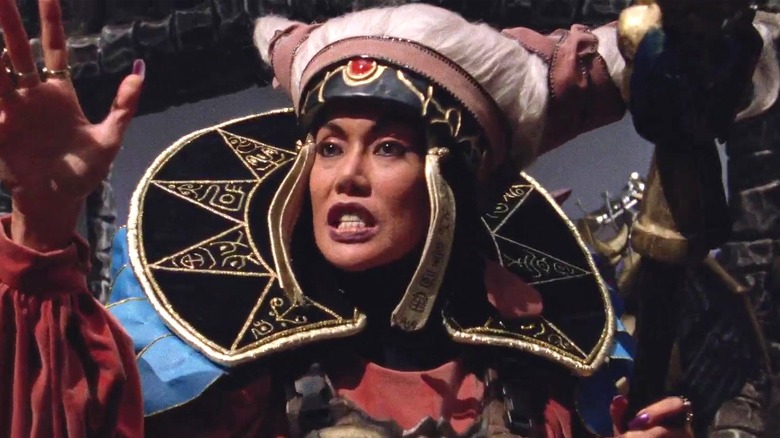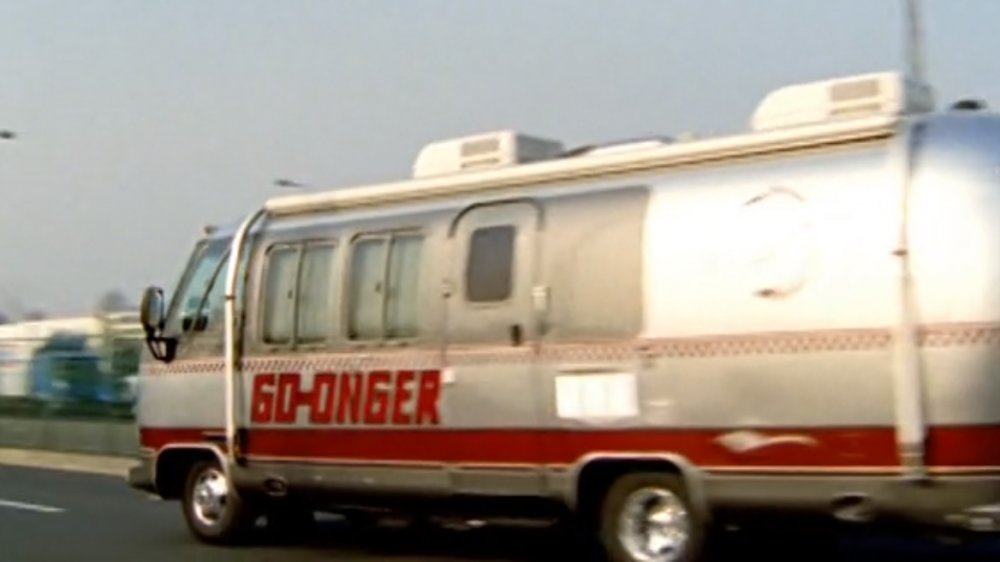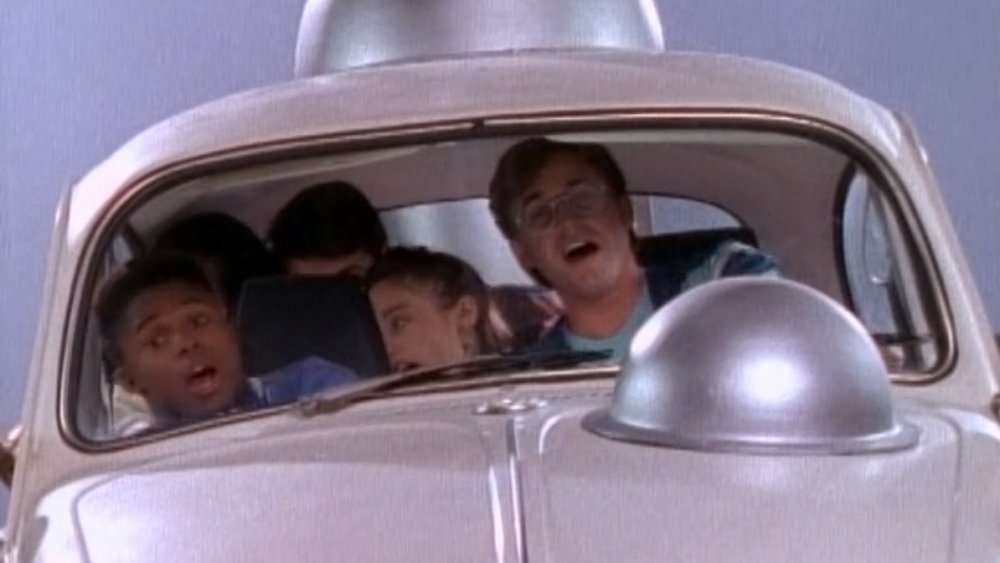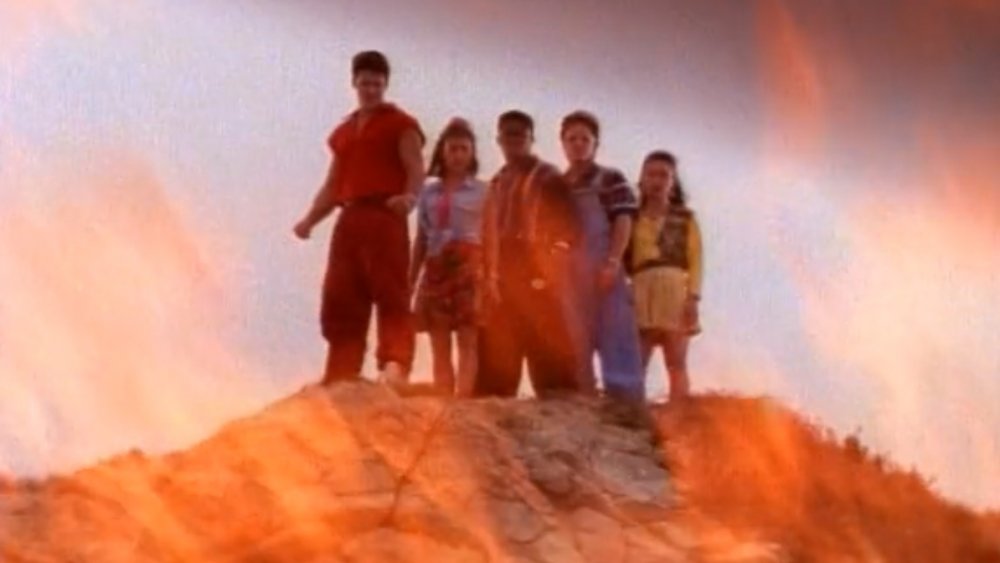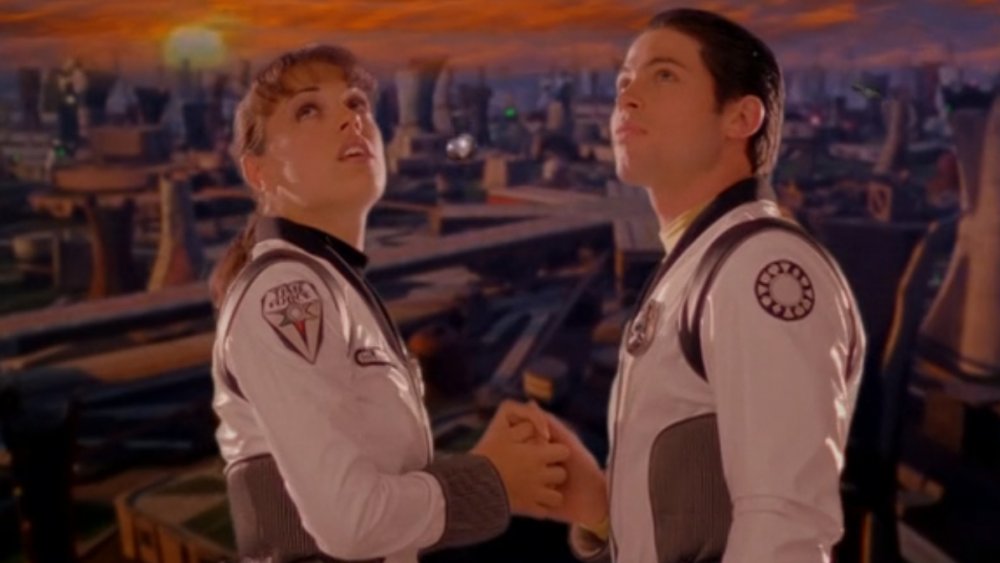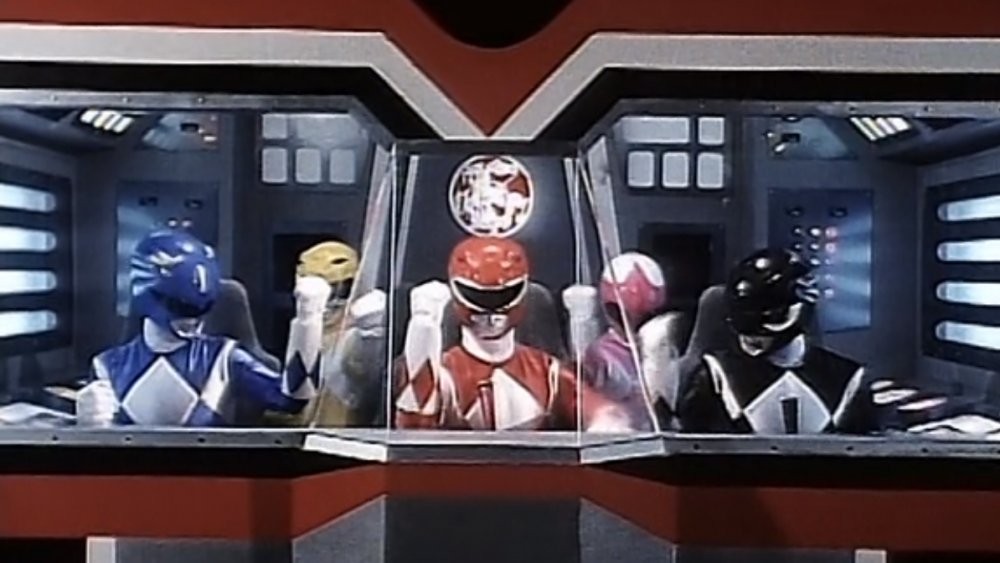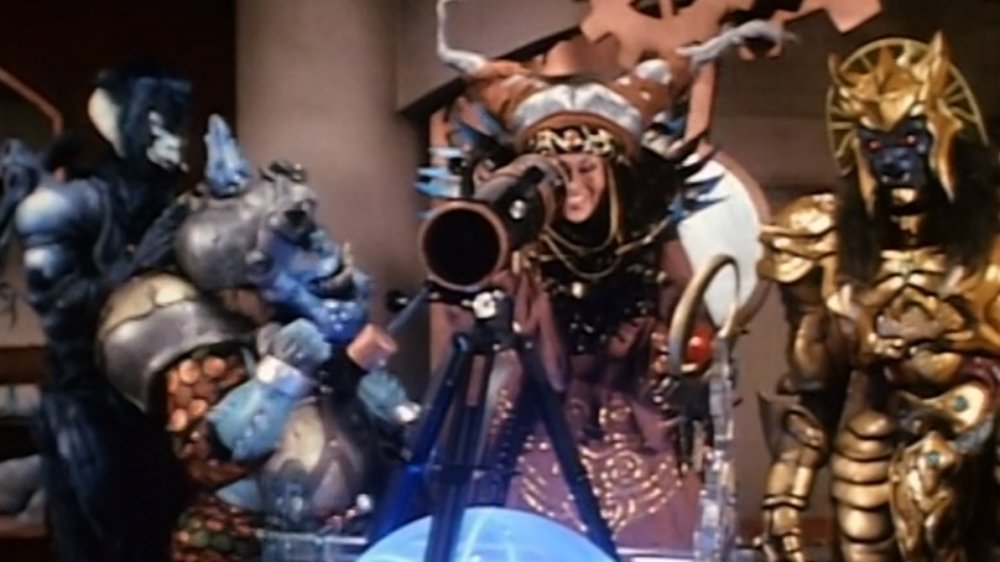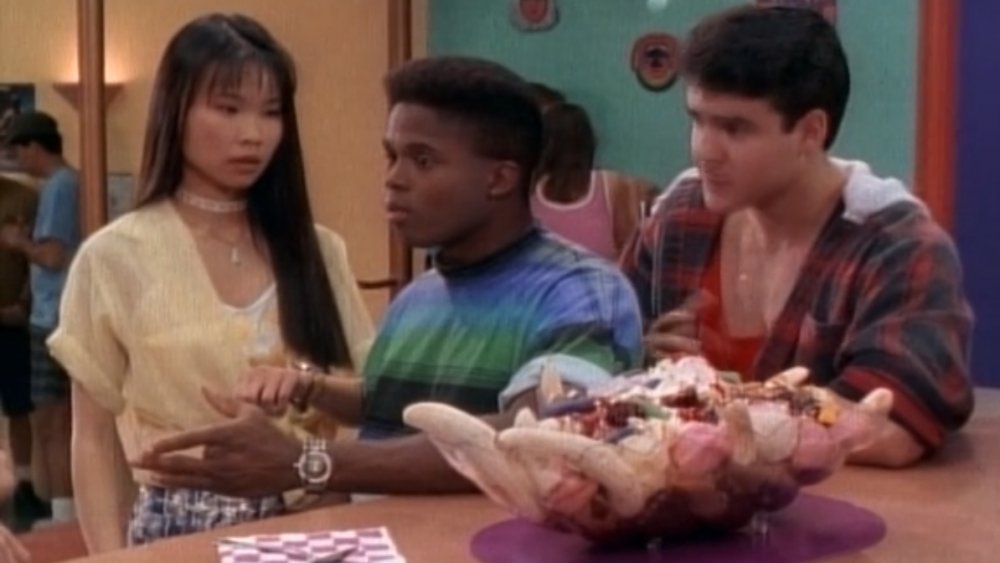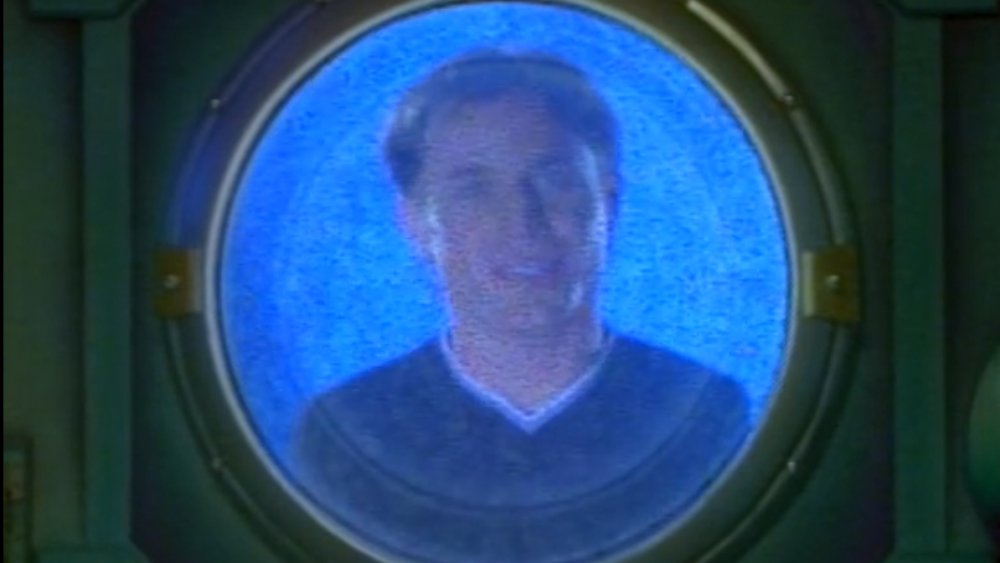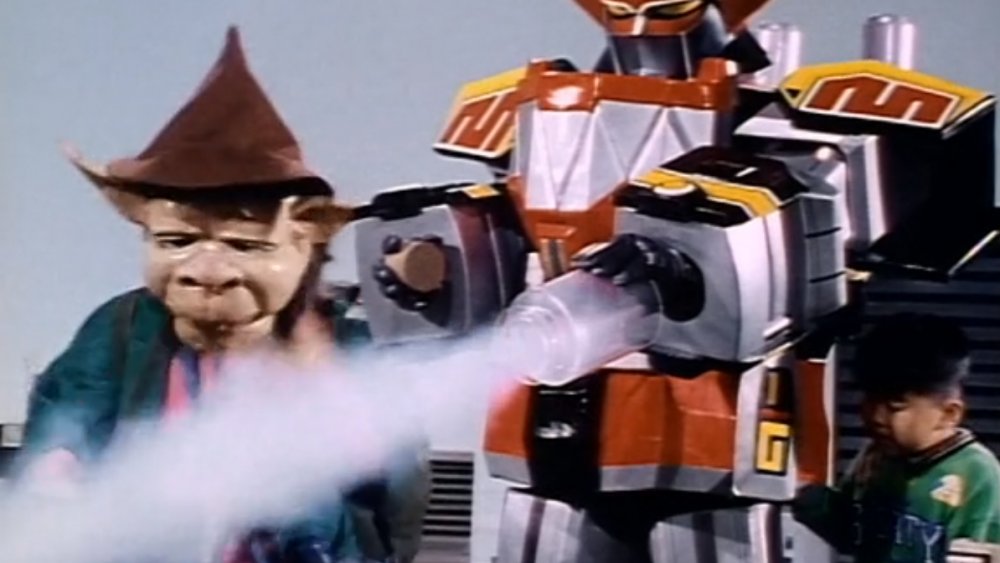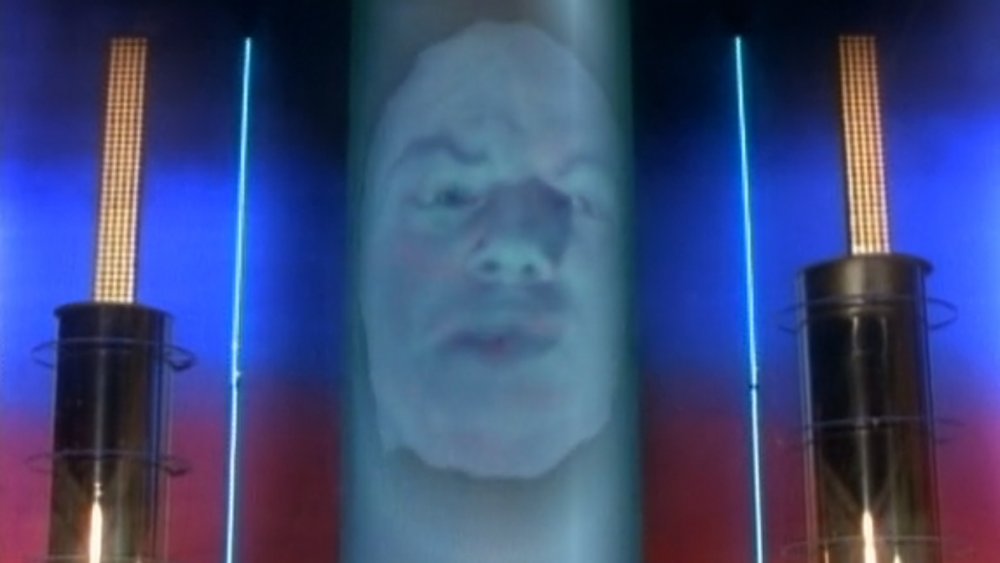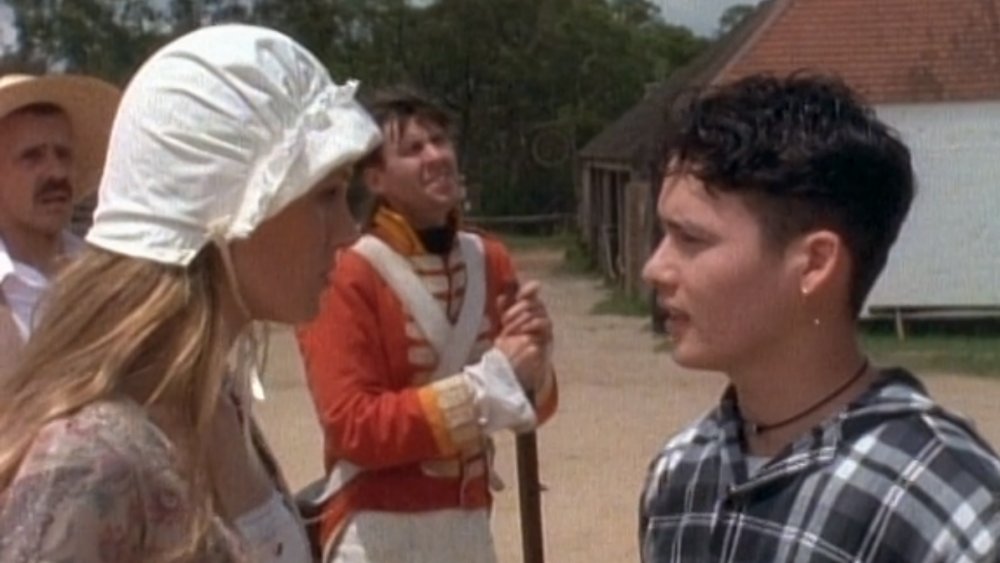Things Only Adults Notice In Power Rangers
Power Rangers first came about because of a strange and brilliant idea. Creators Haim Saban and Shuki Levy realized they could buy the rights to a Japanese TV show called Super Sentai, which features a team of superheroes who fight monsters in face-concealing helmets, re-dub the dialogue in English during the action scenes, and then shoot new footage of the heroes' mundane lives using American actors. This would allow for the creators to make a big-budget action series on a sitcom budget.
The plan worked, and the resulting show was a certified hit. Power Rangers has now had over 25 seasons, and is currently running like a well-oiled machine. But in the early days, this was very much not the case. Don't get us wrong — the action was great, the hard rock soundtrack was killer, and the show had a lot of heart — but during the first few seasons, Power Rangers was a hot mess, full of egregious production goofs, dangling plot threads, and disturbing worldbuilding implications.
For that reason, we're taking a closer look at mainly just those first few seasons of the show, but we'll also be sprinkling in bits from later seasons as well. The many oddities of Power Rangers certainly went over the heads of most kids watching watching during the '90s, but now that those kids have grown up and reached thinkpiece-writing age, we're here to reexamine all the helmet-scratching nonsense that only adults can spot when they watch Power Rangers.
Wacky footage matches
Since much of the footage from Power Rangers is recycled from Super Sentai, one problem that the writers constantly face is how to best hide the gaps between the two TV different shows they are stitching together. Normally these transitions are relatively invisible, but sometimes the show has to do kooky things to connect the dots between the American storyline and the Japanese one.
For instance, in Kyōryū Sentai Zyuranger, the season of Super Sentai that became Mighty Morphin Power Rangers, the Green Ranger dies halfway through the series. The writers of Power Rangers didn't want to kill their Green Ranger, Tommy, so they instead had to write strange contrivances into almost every episode shortly after Tommy joins the team in order to justify his absence in the morphed fight scenes. Tommy has karate practice, Tommy gets captured, Tommy gets injured and has to rest. Over and over again, until the show finally arrives at a permanent solution: Tommy loses his powers.
Perhaps the most hilariously tortured attempt to meld American and Japanese footage occurred during Power Rangers RPM. In it, the Rangers have a high-tech bus with the word "Go-Onger" on the side. That's because the season of Super Sentai that RPM got its footage from was called Engine Sentai Go-onger, where "Go-Onger" is the name of the team. The fix the RPM writers settled on was this bus was called the "Go-Onger," which stands for the "Ground Outdoor Operational Networked General-Purpose Exploration Rover." Sure, guy.
World-changing inventions that are never mentioned again
Mighty Morphin Power Rangers typically draws a pretty hard line between the mundanity of Angel Grove and the zaniness that goes with Ranging Power, but every once in a while — especially in the early episodes — it becomes clear that the writers hadn't really figured out what they were doing with the tone of the sitcom half of the show. That's when they ended up playing complete Calvinball with the laws of physics.
For instance, on the episode "The Dark Warrior," Trini's uncle, a scientist named Howard, invents — no joke — an invisibility potion. When poured on an object, that object vanishes. When a person drinks it, they and their clothes become invisible for a couple minutes. How he invented this potion is never explained. It's largely used just for comedy, and once the episode ends, neither the potion nor Howard are ever mentioned again.
There's also Billy's greatest invention: the oft-maligned Radbug. First appearing in the episode "Big Sisters," the Radbug is a modified Volkswagon Beetle that this ordinary high school student has somehow given the ability to fly. And as if inventing a flying car wasn't enough, Billy claims the Radbug has the ability to accelerate from zero to 3,000 miles per hour in three seconds. It shows up a few times throughout the first season. The last time we see it, it's sitting in Billy's driveway in the episode "Doomsday," and then it's never spoken of again. However, it did pop up again in one of the later Power Rangers comics, in which Lord Zedd turned it into a monster.
The Power Rangers' never say die attitude
Many kids shows of the '90s have an unspoken rule against using the words "kill" or "die." For a show like Rugrats or Goof Troop, that's not really a problem. But for Power Rangers, where our heroes are literally fighting evil aliens to the death in every episode, not talking about death ends up being way weirder and more horrifying than just taking the time to address it every once in a while.
It's not just that the villains are constantly talking about wanting to "destroy" the Rangers — perhaps the best example in history of TV writers staying true to the letter of the law and completely ignoring the spirit of it. The Megazord will also sometimes flatten the odd skyscraper with a poorly placed right hook and no one talks about whether or not there were any people inside.
But by far the biggest dead elephant in the room in any season of Power Rangers happens in Power Rangers RPM. That season takes place in a Terminator-meets-Mad Max post-apocalyptic setting where evil machines have taken over the world, and the Rangers are protecting the last remaining human city on Earth from weekly robot invasions. What happened to all the rest of the cities on Earth? What happened to all the people in those cities? Presumably they were all systematically rounded up and slaughtered by killer robots, but hey, as long as we don't ever say the word "die," it's still a kids' show, right?
A world without kisses
This one's just plain confusing. Among its many strange self-imposed rules, Power Rangers seems to have a prohibition against ever showing kissing on screen. Now, this wouldn't be an issue if the show never had any romance subplots, but there are numerous romantic relationships portrayed throughout the show's many seasons, and the way that the series has to continually dance around showing anyone kissing their romantic partner often times ends up being intensely weird. For instance, in the first episode of Power Rangers: Time Force, we see the Red Ranger Alex proposing to his girlfriend, the Pink Ranger Jen. She accepts, put the ring on her finger... and they hug.
Some seasons actually use this rule for some interesting storytelling, such as in Power Rangers RPM when Summer, the Yellow Ranger, almost has a kiss with Dillon, the Black Ranger, but they are interrupted at the last moment. But more often than not, it's just confusing. For instance, in Power Rangers: Ninja Steel, the actors and writers tried to include a kiss between Hayley the White Ranger and her boyfriend, Calvin the Yellow Ranger, but apparently, the higher ups weren't having it. Zoe Robins, the actor playing Hayley, later confirmed on Instagram, "We tried our very best to squeeze a kiss in the Ninja Steel season finale, but it didn't make the final cut."
The real reason the Power Rangers wait to call the Zords
Power Rangers is often mocked for its formulaic structure, and it's a completely fair criticism. The rangers fight a monster, they win, the monster grows, the Rangers call the Megazord, they beat the monster again. You can set your watch to it. For this reason, the question was often posed on the schoolyard, "Why don't they just use the big robot from the beginning?"
Believe it or not, the show actually addresses this. In the first episode, Zordon tells the teens there are three rules for being a Power Ranger: never use your power for personal gain, never escalate a battle unless you are forced you to, and keep your identity a secret.
The first and third rules are pretty standard superhero fair, but let's talk about that second one. We all know the show is about martial arts, but that second rule reminds us that Power Rangers is also, philosophically, about self-defense. When bullies Bulk and Skull join Jason's martial arts class because they want to learn to "beat people up," Jason tells them, "Martial arts was not developed to hurt others."
In addition to giving the show some deeper themes, Power Rangers' constant emphasis on protection rather than violence also explains why the heroes don't ever, for instance, launch a pre-emptive attack on Rita's moon palace. It also probably isn't an accident that this message would've given the show's creators a reasonable defense in court if two kids hurt each other while "playing Power Rangers" and the parents decided to sue.
Wait, the bad guys just know the Rangers' secret identities?
Like many superheroes, the Power Rangers have secret identities. Ostensibly, the reason that most heroes hide their superheroism from their friends and loved ones is because they want to keep them safe from villains. The weird thing about the Power Rangers is that even though Bulk, Skull, and Ernie don't know their identities, all the villains do. From the very beginning of the show, Rita knows who the Rangers are, who they're dating, where they sleep at night, all that stuff.
The villains do sometimes use this knowledge to their advantage, but they never really cut loose and do something really evil. Rita sends Squat into Trini's bedroom one time while she's sleeping, but all Squat does is steal one of her dolls and transform it into a monster which attacks the city. Baboo realizes that he can slip something into the Rangers' unattended drinks as they're off playing volleyball, but he opts for giving them a magic potion in it that transforms them into angsty punks, rather than, y'know, arsenic. They seem to follow a similar philosophy of villainy as Austin Powers' Dr. Evil — they definitely want to kill their nemeses, but there's an unspoken code of conduct when it comes to how bad guys are supposed to act. You could just have a giant monster step on their house while they're asleep, but where's the sport in that?
Zack's missing finger
It's never mentioned during the show, but Walter Jones, the actor who plays Zack, is missing the middle finger on his left hand. Apparently he lost the finger during an accident when he was four years old.
It's such a subtle detail that you'd probably never notice it, even if you watched the entire series multiple times. There aren't many close-ups of Zack's hands, and the low-res VHS quality of most versions of the show means that it's kind of difficult to see anything in all that much detail. Complicating matters even further is the fact that, when Zack is morphed — and thus played by another actor — he suddenly has all ten fingers. Maybe the energy of the Morphin' Grid, in addition to granting the teens superhuman strength and reflexes, also gives them temporary superhuman regeneration, like the Lizard from Spider-Man.
As fun as that is to think about, unfortunately, we think the real explanation for why Zack sometimes has nine fingers and sometimes has ten is the same explanation that always lays at the heart of any of the myriad incongruities and mysteries that are woven throughout the slapdash worldbuilding of Power Rangers: you're just not supposed to think about it that hard. They didn't even bother to give him nine fingers in the comic books.
Unceremonius exits from the world of Power Rangers
Over the first few years of Power Rangers, the cast had a surprising amount of turnover. You wouldn't know why Rangers keep leaving the team as a kid, but when you start looking into it as an adult, you discover that the root of this problem was that, according to many people involved, the show tended to treat its actors like garbage.
Perhaps it isn't surprising, since the germ of the idea that became Power Rangers was born from a desire to save money, but the five original Rangers were paid terribly — only $600 an episode. Because of this, three of the original Rangers — Austin St. John (Jason), Thuy Trang (Trini), and Walter Jones (Zack) — quit the show early in season 2, and their characters were abruptly written out and replaced by three new teens.
Amy Jo Johnson (Kimberly) quit a year later, and the last original Ranger, David Yost (Billy), quit a year after that. In his case, poor pay wasn't necessarily the issue — it was rampant and systematic homophobia. Yost claims that he walked off set halfway through the filming of an episode after being called homophobic names and never returned. He was written out of the show in an extremely clunky fashion, with his character moving away to an alien planet. The last we see of him is a blurry recording sent back to Earth that is clearly just old footage of Yost combined with new audio of someone doing a bad Billy impression. It would be years before Yost returned to the franchise.
The giant boy who lives in downtown Angel Grove
We may be looking at things in Power Rangers that only adults would notice, but to be fair, this one's so obvious that some kids probably noticed it, too. In the episode "For Whom the Bell Trolls," as the Megazord is fighting the villain of that episode, Mr. Ticklesneezer, there's a truly bizarre moment that utterly shatters the reality of the world. In one brief shot, without warning or explanation, there is a child standing alongside the Megazord in the lower right corner of the screen. The child comes up to the Megazord's waist, and given the scales we're theoretically operating at here, that would make the kid about 15 stories tall. The kid is never addressed in the dialogue, appears briefly again in one more shot, and then is just gone entirely.
This is actually a remnant from the episode of Super Sentai from which "For Whom the Bell Trolls" was adapted. In that episode, a child named Toshio does indeed grow to Megazord scale. That element of the story was cut for the American adaptation, but either no one noticed the kid standing next to the Megazord when this shot was being spliced into Power Rangers, or no one cared. Part of us wishes that someone had caught this one during the edit, though, as we'd like to hear what sort of quick voiceover line they'd come up with for Zordon to try and explain this one away.
Is Zordon just racist against monsters?
Make no mistake: the Power Rangers kill a lot of monsters. We're supposed to take it as a given that these monsters are unrepentantly evil... but why? Most are fully capable of speech and a wide range of emotions. There's an entire arc in Power Rangers Zeo where the villains Goldar and Rito get amnesia and temporarily become good guys. Is it possible that Zordon just doesn't like freaky-looking aliens?
Some evidence for Zordon's potential bigotry might lie in the episode "Countdown to Destruction." In it, the United Alliance of Evil is on the verge of conquering the entire universe. So Zordon, all-powerful mentor of the Power Rangers, sacrifices himself, unleashing a massive energy wave that is theoretically supposed to purge the universe of all evil. Some of the recurring villains who are hit by this wave are annihilated, whereas others just have the evil within them destroyed, and instantly become good guys.
You'd imagine that the monsters who are destroyed would be the truly vile ones, and the kinder, more redeemable villains would be spared, but that's not how things go down. Ecliptor, for instance, is destroyed, despite continually showing deep affection and loyalty towards his foster daughter Astronema, whereas many of the show's worst villains, such as Rita, Zedd, and Divatox, are spared. What Zordon's energy wave actually seems to be using as its criteria for separating the sheep from the goats is just whether or not you look like a human. Not cool, dude.
Redcoats in Angel Grove?
The tangled continuity of Power Rangers is often a complete mess. But luckily, Power Rangers fans work way harder than the writers do at making it all make sense, and every once in a while, they discover two dangling threads of worldbuilding that combine to make something truly genius. What follows is one such example — it seems like a simple mistake, but if you keep thinking about it way too hard, you eventually hit gold.
It's often implied that Angel Grove is in California, as that universe's equivalent of Los Angeles. However, in a miniseries called "The Return of the Green Ranger," the gang travels back in time to the 1700s, and they see British Redcoats patrolling the streets of Angel Grove, indicating that the teens are in a time before U.S. independence. There's only one problem with that: the Spanish colonized California, not the British.
You could write this off as an error. Whoever wrote this episode forgot that Angel Grove was an analog of Los Angeles, and thus probably wouldn't have Redcoats in it during the 1700's. But for a moment, don't do that. Trust that it all makes sense and just keep going deeper. If Power Rangers takes place in an alternate reality where the British settled California instead of the Spanish, the city of Los Angeles would probably an English name instead of a Spanish one. So instead of "Los Angeles," how about "Angel Grove?" Is this total nonsense, or did we just crack this thing wide open?
